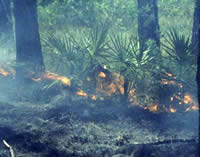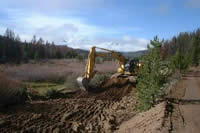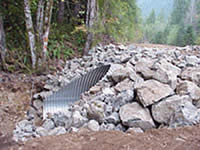- Forest Service Home
- Ecological Restoration
USDA Forest Service Ecological Restoration
|
|
|
 |
|
 Ecological Restoration
Threatened Forests and Grasslands and the Need for ActionThe Forest Service mission is to sustain the health, diversity, and productivity of the nation's forests and grasslands to meet the needs of present and future generations. In this century, our forests and grasslands face serious threats to their sustainability from a variety of stresses and pressures. Foremost are climate change, altered disturbance regimes, non-native invasive species, and increasing pressures and impacts from an expanding human population. These diverse threats affect aquatic and terrestrial ecosystems in virtually every region of the country and are a major basis for Chief Kimbell’s focus on climate change, water resource issues, and reconnecting people with nature. "Restoration" is a common way of describing much of the Forest Service’s work aimed at addressing these issues on National Forest System lands. The Forest Service has conducted restoration-related activities across many programs for decades and the concept of restoration is threaded throughout existing program directives and collaborative efforts such as the National Fire Plan 10-Year Comprehensive Strategy and Implementation Plan (PDF, 0.5 mb). However, an internal Forest Service study, Ecosystem Restoration: A Framework for Restoring and Maintaining the National Forests and Grasslands (PDF, 2.39 mb), also known as the Restoration Framework, determined that the concept of ecological restoration has not been well understood nor consistently implemented within the agency. The Framework’s key recommendation was to establish broad restoration policy, guidelines, and definitions. New PolicyChief Kimbell has issued this policy as an interim directive for a new title to the Forest Service Manual (FSM). FSM 2000 – National Forest Resource Management, Chapter 2020 – Ecological Restoration and Resilience (.doc, 112 kb) articulates foundational policy for restoration of National Forest System lands and associated resources. The policy will guide achievement of sustainable management to continue providing a broad range of ecosystem services. Healthy, resilient landscapes will have greater capacity to survive natural disturbances and large-scale threats to sustainability, especially under changing and uncertain future environmental conditions, such as those driven by climate change and increasing human uses. The interim directive provides an overarching and unifying policy for Forest Service employees, partners cooperators, and other stakeholders to more effectively communicate restoration needs and objectives at the local, regional, and national levels. The scope of the policy is broad - all resource management programs have a responsibility for ecological restoration. This policy will enable the Forest Service to address 21st century environmental issues more effectively, such as adaptation to climate change and increasing threats from wildfires, insects, pathogens, and invasive species. The policy applies to National Forest System lands only.
A Definition of "Restoration"FSM 2020 defines Ecological Restoration as "the process of assisting the recovery of resilience and adaptive capacity of ecosystems that have been degraded, damaged, or destroyed. Restoration focuses on establishing the composition, structure, pattern, and ecological processes necessary to make terrestrial and aquatic ecosystems sustainable, resilient, and healthy under current and future conditions." The new policy broadens the definition of ecological restoration beyond the traditional approach of reestablishing specific past resource conditions, such as those defined by historical range of variation. Because restoration objectives reflect diverse public values, ecological restoration is based upon collaboration. Why an Interim Directive?The policy provides a foundation for or complements other national efforts including the 2008 Planning Rule, Woody Biomass Utilization Strategy, Forest Service Strategic Framework for Climate Change, and new policy being developed for large-scale event recovery to assist restoration efforts after events such as Hurricane Katrina. It also supports development of proposed legislation, such as the Forest Landscape Restoration Act of 2008. These efforts will position our agency to address the increasingly complex challenges we face in accomplishing our mission. This direction, combined with close collaboration with the public, will guide the work ahead. By issuing this interim directive, the Forest Service is addressing the immediate need for this policy while affording an opportunity to "field test" it. The Forest Service will also pursue consultation with Indian Tribes and seek public comment in developing a final directive. More Information |
|
| NOTE: PDF format links require the Adobe Acrobat Reader to view. | |
| top | Disclaimers | FOIA | Privacy Policy | Quality of Information |
Location: http://www.fs.fed.us/restoration/index.shtml
Last modified: Monday, 22-Sep-2008 11:02:00 EDT



